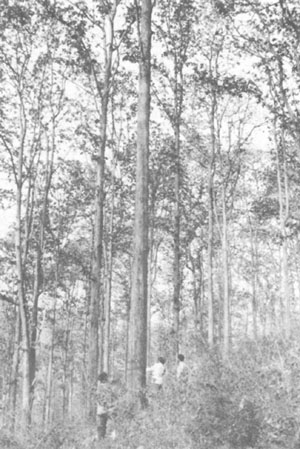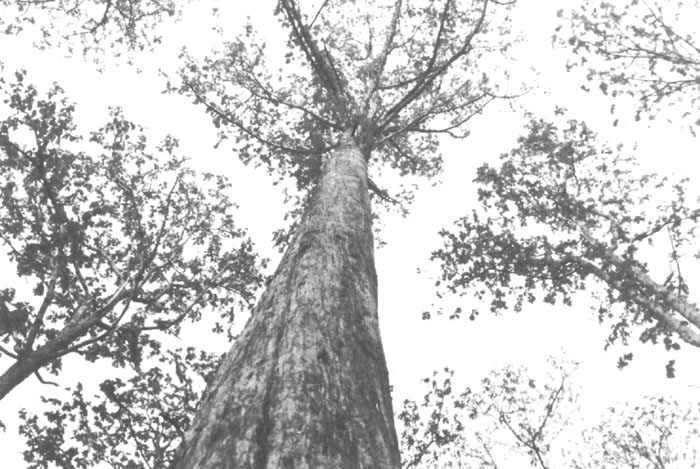by
K.N. Subramanian, A. Nicodemus and A. Radhamani,
Institute of Forest Genetics & Tree Breeding,
Coimbatore 641 002, INDIA
INTRODUCTION
Teak (Tectona grandis L.f.) is the most celebrated timber tree of India. The history of commercial teak planting dates back to 1844 when the then Collector of Malabar, Mr. Conolly foresaw the shortage of teak likely to occur through the depletion of the natural forests (Troup 1924). Today, nearly 100,000 hectares are planted with teak annually in India.
Establishment of “teak seed origin sample plots” during the early thirties was the first step towards understanding the genetics of teak. Systematic teak improvement started with the submission of a report by Matthews (1961) to the Government of India. In 1962 Kedharnath and Matthews formulated a programme for the genetic improvement of teak. Following this, the improvement activities gained momentum and almost all the teak growing states have now joined teak improvement programmes.
The main objective of teak improvement programmes is to achieve, by selection and breeding, superior stem form and timber quality, fast growth (height and diameter), a trunk free from fluting, buttressing and epicormic branches, resistance to leaf skeletoniser, defoliator, drought and frost.
The teak forests in India are classified into the following five major types, mainly based on the rainfall: very dry, dry, semi-moist, moist and very moist types. Distinct genetic variation can be found in the teak of the above different types, and this is taken into consideration in the improvement programmes of teak.
SEED PRODUCTION AREAS
Since the area to be planted with teak every year is high, large quantities of quality seeds is required. Seed stands/seed production areas are identified and maintained to meet the immediate needs. Seed stands and seed production areas are only interim arrangements until seeds from seed orchards are available. So far more than 3000 hectares of seed stands and seed production areas have been identified in India and are managed for seed production (see figure 1)

Figure 1. Seed production area of teak in Seechalai, Tamil Nadu, India (Photo: B. Gurudev Singh).
PROVENANCE TRIALS
To gain understanding of the importance of seed source and ecotype variation of teak, the “All India Teak Seed Origin Sample Plots” were established during 1934–36. These are among the oldest provenance trials of teak in the world. These trials showed that genetic differences due to origin exist in teak and that local sources often compare well with introduced ones. For example, the results of a provenance trial at Topslip, Tamil Nadu in India, which included four provenances, indicated the local provenance to be the best (Kumaravelu 1993). These early trials also indicated that interaction between site and provenance may be important and that more accurate experiments were required to further clarify this aspect.
During the seventies, a series of internationally coordinated provenance trials of teak was conducted under a action programme following a recommendation made by the FAO Panel of Experts on Forest Gene Resources in 1969. The international trials were coordinated by the DANIDA Forest Seed Centre, Denmark. Out of a total 64 provenances collected from all teak growing regions, more than half (35 provenances) were from India. A provenance trial was established with 11 provenances at Maredumilli, Andhra Pradesh (India). The final evaluation of this trial during 1981–83 showed that the Indian provenances performed better in health and growth, whereas Thailand provenances outperformed Indian provenances in tree form and quality. The only African landrace included in the trial was found to be superior in growth (Keiding et al 1986).
PLUS TREE SELECTION
Identification of plus trees from natural forests and plantations has been carried out as part of the teak improvement programmes. A plus tree (figure 2) is an phenotypically outstanding individual combining a number of desirable traits. While selecting plus trees of teak, each superior tree is compared with at least 5 trees within a radius of 50 meters from the plus tree. In order to determine the superiority of the plus tree, a scoring system is adopted for characters like height, diameter, clear bole height, straightness of stem, branching pattern, resistance to pests and diseases, and for seed production.
Figure 2. Plus tree of teak from Topslip, Tamil Nadu, India (Photo: B. Gurudev Singh)

To date, about 1,000 plus trees and candidate plus trees have been selected throughout the country in the different ecotypes of teak. Usually bud material is collected from these trees and clone banks are established by grafting the buds to stocks raised from locally available seeds. The establishment of clone banks facilitates subsequent collection of seed and bud material from the plus trees and ensures that the genetic material is available from them even if the plus trees themselves are lost. Attempts have also been made to characterise each clone through isozyme analysis (Kumaravelu 1979).
SEED ORCHARDS
The first experimental clonal seed orchard of teak was established at the New Forest campus of the Forest Research Institute, Dehra Dun. It was a 20 clone seed orchard which started producing seed from the fifth year after establishment. Following this, many states like Andhra Pradesh, Gujarat, Madhya Pradesh, Tamil Nadu and Uttar Pradesh have established seed orchards of teak. Three pilot clonal seed orchards with 50 clones each were established by the Kerala Forest Research Institute. The total area of teak seed orchards in different states is nearly 1,000 hectares (Kumaravelu 1993). The present work includes also pollarding, fertilization and application of growth regulators.
The most common problem encountered in teak seed orchards in India is the asynchrony of flowering among different clones assembled in the orchard. Some clones flower at an early age (e.g. 4–5 years) whereas some others flower only after 10–15 years. Sometimes when a clone belonging to one particular ecotype (e.g. dry/moist) is included in a seed orchard established in an area of another ecotype it may not flower at all for 40 years or more1.
PROGENY TESTING
Ideally, establishment of seed orchards should be preceded by progeny testing of the phenotypically selected plus trees to evaluate their genetic value. This enables to separate those trees whose superiority may have resulted from growing in favourable environments from those that are superior because of their genotype. However, in order to meet the immediate demand for quality seeds, and considering the long rotation period of teak, progeny testing is either conducted simultaneously with the establishment of seed orchards, or at a later stage using seeds collected from the seed orchard itself.
Seedlings raised from open pollinated seeds (half sibs) of 20 different clones from the clonal seed orchard at Walayar (Kerala) were planted at Nilambur (Kerala) for progeny testing during 1991. Analysis of variance on data of one year old seedlings revealed significant differences among clones for mean values. Six clones KLS1, KLN 2, KLN 4, TNT 3, TNT 10 and TNT 11 recorded significantly higher mean values in important characteristics than Nilambur local. Fair differences were obtained between phenotypic and genotypic coefficients of variability. As expected, heritability (narrow sense) and genetic gain were of low magnitude. The clones, KLS 4, KLN 4 and TNT 10 were found to have good general combining ability and high breeding value.
VEGETATIVE PROPAGATION (INCL. TISSUE CULTURE)
Teak is mainly propagated through seeds. Though techniques for rooting cuttings (Mahmood Hussain 1976) and grafting (Kedharnath and Venkatesh 1963) have been standardised, they are not employed in commercial teak planting programmes in India. Nevertheless, the techniques are useful for breeding programmes when establishing clonal seed orchards. Also tissue culture techniques have been standardised for teak (Mascarenhas et al 1987). Plantlets derived through tissue culture have been field planted to test their performance as compared to seedlings. Early growth data from these trials indicate that tissue cultured plants produced from old trees have better growth than the open-pollinated seedlings from the same trees. (Kumaravelu 1993). Although, this result seems logical, it needs verification.
FUTURE STRATEGIES
Action has been initiated to develop a definite written breeding plan for teak in India in order to achieve continuous improvement of the species. This plan will include the steps of provenances testing, selection of plus trees, establishment of seed production areas and clonal seed orchards, and progeny testing. Vegetative propagation techniques will be further perfected in an effort to make clonal plantations an economically feasible option for plantations. The breeding plan will also include selection and breeding against damage by skeletonizer and defoliators of teak, through crossing of Tectona grandis and T. hamiltoniana; this latter species has been found to be relatively resistant to the insects causing damage. To date, crosses attempted between these two species have yielded seeds, which were shrivelled and did not germinate. Embryological studies revealed that fertilisation takes place in the cross but the embryo aborts in the early stages of development. In vitro embryo culture may help in rescuing the embryo and to develop hybrid plants.
REFERENCES
Kedharnath, S. & Matthews, J.D. (1962). Improvement of teak by selection and breeding. Indian Forester 88:277–284.
Kedharnath, S. & Venkatesh, C.K. (1963). Grafting as an aid to the breeding of teak (Tectona grandis L.f.) and Semul (Salmalia malabarica Schott Ex Endl.) FAC Fogen, Vol.II(63): 5–6.
Keiding, H.; Wellendorf, H & Lauridsen, E. (1986) Evaluation of an international series of teak provenance trials. (DANIDA Forest Seed Centre. Misc. paper) 81 pp.
Kumaravelu, G. (1979). Isozyme characterization of teak clones. Indian Forester 95.
Kumaravelu, G. (1993). Teak in India. In Henry Wood (ed.) Teak in Asia, FORSPA Publication No. 4, Bangkok. pp. 27–34.
Mahmood Hussain, A.M., Somasundaram, T.R., & Subramanian, K.N. (1976). A recent advance in teak culture. Indian Forester 102(8): 531–532.
Mascarenhas, A.F., Kendurkar, S.V., Gupta, P.K., Khuspi, S.S. & Agrawal, D.C. (1987). Tissue culture in Teak. In Bonga, J.M. & Durzan, J. (eds.) Cell and Tissue Culture in Forestry, Vol.II.
Matthews, J.D., (1961). A programme of forest genetics and forest tree breeding. FAO/ETAF Report No. 1349. Rome.
Troup, R.S. (1921). The Silviculture of Indian Trees, Vol. II Oxford University Press, Oxford.
Forest Genetic Resources No. 22. FAO, Rome (1994)
Manuscript received July 1994